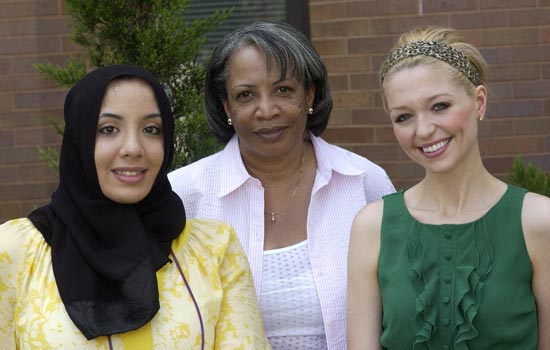Advocates Ask Fashion Industry to Support Braille Clothing Tags, Talking Web Site
RIT team will speak in Rome at the Fashion for Good Roundtable in July
A. Sue Weisler
Asmah Abushagur, left, Wilma King, associate professor of communication, and Jaimen Brill will attend the Fashion for Good Roundtable in July in Rome.
Imagine coordinating your wardrobe in the dark. It’s not something Armani, Prada or Fendi think about when designing clothes. For them, a little black dress speaks for itself and doesn’t need a safety pin or special tag for description.
Yet, every morning, millions of blind or visually impaired people reach into their closets to read the Braille-embossed aluminum tags sewn into their clothes or the coding system of safety pins they’ve devised to identify their garments.
Two women who met as students at Rochester Institute of Technology want to give the blind and visually impaired community more independence in choosing their wardrobe and more confidence when dressing for success.
Jaimen Brill and Asmah Abushagur are in the process of forming the non-profit organization White Cane Label to help the blind and visually impaired shop for clothing and coordinate their outfits. They are advocating for an interactive, talking Web site and standardized, Braille-embossed clothing tags made of cloth, not aluminum, to be sewn onto all garments.
The user-friendly Web site will include a questionnaire to gauge personal style, clothing recommendations and detailed descriptions of each item in different styles and price ranges. The Braille clothing labels will include three symbols indicating the brand, color and coordinating style for mixing and matching individual pieces. A second label will include washing instructions in Braille.
Brill and Abushagur chose the name for their organization based on White Cane Day, or Oct. 15, the annual day of awareness in the United States for issues facing the blind. The day is named for the familiar white cane used by millions of people.
“If White Cane Day is the only single day that exists for them, then White Cane Label is pretty obvious,” says Brill, who graduated in May from RIT with a bachelor’s degree in advertising and public relations.
“This is a new idea; it’s never been done before,” she says.
“We are very confident that, once the idea is put on the table, people will begin to believe in it just as much as we do,” adds Abushagur, a fourth-year marketing major at RIT’s E. Philip Saunders College of Business.
Next month, Brill and Abushagur will pitch their ideas to leaders of the fashion world during fashion week in Rome, July 9-13. The women will present their concept for White Cane Label at the Fashion for Good Roundtable in hopes of soliciting the kind of support that has brought attention to prominent causes like AIDS awareness, breast cancer research and the anti-fur campaign. Brill and Abushagur will ask the industry to include Braille labels on their garments. They will also request initial donations of clothing and accessories to stock the Web site store they plan to debut in fall 2009.
The Fashion for Good Roundtable is sponsored by Alta Roma, the fashion association in Rome. The biannual roundtable, formed in 2002, brings together leaders of the fashion and non-profit worlds to encourage ethical and socially responsible practices. In January, the Fashion for Good Roundtable’s focus on underweight models and eating disorders gained attention worldwide.
Previous roundtable participants have included designers Anna Fendi, Pierre Cardin and Laura Biagiotti, as well as fashion journalists, ambassadors and diplomats, among others.
“Fashion has the power to bridge or separate people,” says Wilma King, associate professor of public relations at RIT and co-founder of Fashion for Good with Giancarlo Polenghi, corporate executive officer of Marketing Communication Mix in Florence. “I think the fashion industry is looking for innovative and sincere approaches to social responsibility. I have every confidence it will embrace and love White Cane Label.”
Brill and Abushagur met in King’s Public Relations class in fall 2006. White Cane Label grew from a class assignment to develop an awareness campaign for a special needs group.
King approached her students with a problem a blind acquaintance had shared with her—the difficulty he faced dressing himself and knowing what to wear as the head of a corporation.
The women brainstormed ideas and checked the Internet. They learned that, in 2005, the World Health Organization reported 46 million blind people and 161 million visually impaired people.
“We thought all our ideas had to have been done,” Brill says.
“We Googled it and found out there was nothing, period, out there for the blind other than aluminum tags, which have to be sent to a Braille printing company (and then sewn onto a garment) and the recommendation of coding your clothes with safety pins on the tags,” says Abushagur. “It seemed kind of outrageous that nothing has been done to help the blind and visually impaired.”
Talking Web site technology is expensive, costing around $2,000, according to Brill. The advocates hope to make the technology available to more people by offsetting the cost with White Cane Label proceeds.
Once White Cane Label is operational, Brill and Abushagur plan to extend the Web site to become a global community resource for the blind and visually impaired. Proceeds made by White Cane Label will go back into the organization and fund scholarships for the blind and visually impaired. Profits will also be used to help fight preventable blindness in children living in developing countries.
“Fashion is just the starting point,” Brill says.
Rochester Institute of Technology is internationally recognized for academic leadership in computing, engineering, imaging technology, and fine and applied arts, in addition to unparalleled support services for students with hearing loss. More than 15,500 full- and part-time students are enrolled in RIT’s 340 career-oriented and professional programs, and its cooperative education program is one of the oldest and largest in the nation.
For nearly two decades, U.S. News & World Report has ranked RIT among the nation’s leading comprehensive universities.









